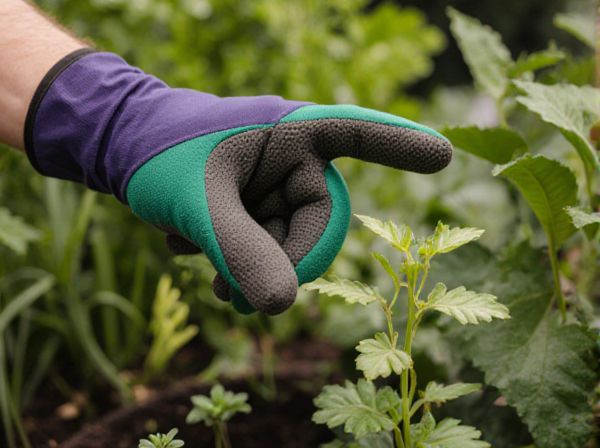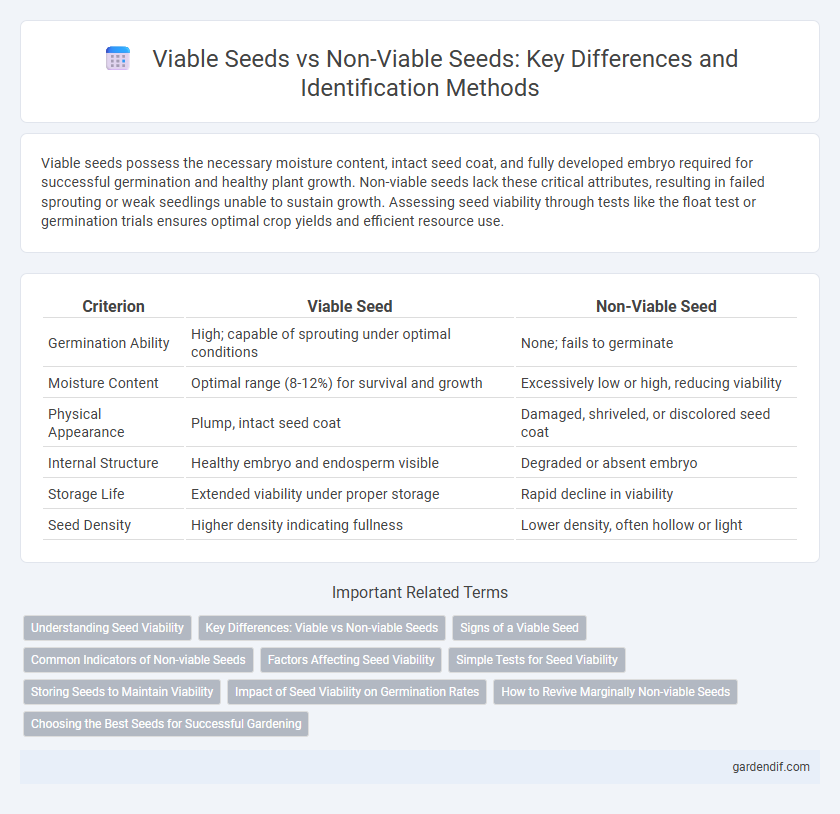
Viable seed vs Non-viable seed Illustration
Viable seeds possess the necessary moisture content, intact seed coat, and fully developed embryo required for successful germination and healthy plant growth. Non-viable seeds lack these critical attributes, resulting in failed sprouting or weak seedlings unable to sustain growth. Assessing seed viability through tests like the float test or germination trials ensures optimal crop yields and efficient resource use.
Table of Comparison
| Criterion | Viable Seed | Non-Viable Seed |
|---|---|---|
| Germination Ability | High; capable of sprouting under optimal conditions | None; fails to germinate |
| Moisture Content | Optimal range (8-12%) for survival and growth | Excessively low or high, reducing viability |
| Physical Appearance | Plump, intact seed coat | Damaged, shriveled, or discolored seed coat |
| Internal Structure | Healthy embryo and endosperm visible | Degraded or absent embryo |
| Storage Life | Extended viability under proper storage | Rapid decline in viability |
| Seed Density | Higher density indicating fullness | Lower density, often hollow or light |
Understanding Seed Viability
Viable seeds contain living embryos capable of germination under optimal conditions, ensuring successful plant growth and crop yield. Non-viable seeds lack the ability to germinate due to damaged embryos, poor development, or adverse environmental factors, leading to reduced agricultural productivity. Understanding seed viability through tests like the tetrazolium assay or germination trials is crucial for improving seed quality and optimizing planting strategies.
Key Differences: Viable vs Non-viable Seeds
Viable seeds possess the ability to germinate and develop into healthy plants due to their intact embryo and sufficient nutrient reserves, whereas non-viable seeds lack these essential qualities, resulting in failed or no germination. Key differences include morphological attributes such as seed coat integrity, weight, and moisture content; physiological factors like metabolic activity and enzymatic function; and genetic viability assessed through tetrazolium tests or germination trials. Accurate distinction between viable and non-viable seeds is crucial for agriculture, affecting crop yield, seed storage decisions, and overall plant propagation success.
Signs of a Viable Seed
A viable seed exhibits firm texture, consistent color, and a healthy embryo visible upon careful examination. It typically sinks in water during flotation tests, indicating adequate density and full development. High germination rates and strong seedling vigor confirm its potential for successful plant growth.
Common Indicators of Non-viable Seeds
Common indicators of non-viable seeds include discoloration, shriveling, and an absence of firmness when gently pressed. Such seeds often exhibit mold growth, cracks in the seed coat, or a hollow sound when tapped, signaling potential internal decay. These visual and tactile markers are crucial for distinguishing non-viable seeds from those likely to germinate successfully.
Factors Affecting Seed Viability
Seed viability is influenced by genetic makeup, environmental conditions during seed development, and storage practices affecting moisture and temperature levels. Exposure to extreme temperatures, high humidity, and pathogen infection can significantly reduce seed viability, leading to non-viable seeds incapable of germination. Proper drying, controlled atmosphere storage, and seed treatment techniques help maintain seed vigor, ensuring higher germination rates in viable seeds.
Simple Tests for Seed Viability
Simple tests for seed viability include the water soak test, where viable seeds typically sink while non-viable seeds float due to lower density. Another common method is the cutting test, which involves slicing seeds open to check for firm, healthy embryos indicative of viability. The germination test remains a reliable approach, observing seed sprouting under controlled conditions to directly assess viability rates.
Storing Seeds to Maintain Viability
Storing seeds in cool, dry, and dark conditions significantly enhances their viability over time by reducing metabolic activity and preventing mold growth. Viable seeds retain high germination rates when maintained at optimal humidity levels below 8% and temperatures near 5degC. Non-viable seeds often result from improper storage environments that expose them to moisture, heat, and light, accelerating deterioration and loss of germinative potential.
Impact of Seed Viability on Germination Rates
Viable seeds contain living embryos capable of germination, directly affecting high germination rates essential for successful crop establishment and yield. Non-viable seeds lack the ability to germinate, leading to reduced germination percentages and uneven plant stands, which can compromise overall agricultural productivity. Optimizing seed viability through proper storage and handling ensures maximum germination efficiency and uniform crop growth.
How to Revive Marginally Non-viable Seeds
Marginally non-viable seeds can be revived by soaking them in water for 12-24 hours to rehydrate and stimulate metabolic processes essential for germination. Scarification, such as gently nicking the seed coat or using sandpaper, improves water absorption for hard-coated seeds, increasing the chances of successful sprouting. Maintaining optimal temperature and moisture conditions during germination also enhances seed viability and encourages robust seedling growth.
Choosing the Best Seeds for Successful Gardening
Viable seeds exhibit strong germination rates and healthy embryo development, ensuring robust plant growth and higher yields in gardening. Non-viable seeds lack the ability to sprout due to factors like poor genetics, seed age, or improper storage conditions, leading to wasted resources and poor garden outcomes. Selecting certified, fresh seeds from reputable suppliers enhances the likelihood of successful germination and thriving plants in any garden setting.
Viable seed vs Non-viable seed Infographic

 gardendif.com
gardendif.com